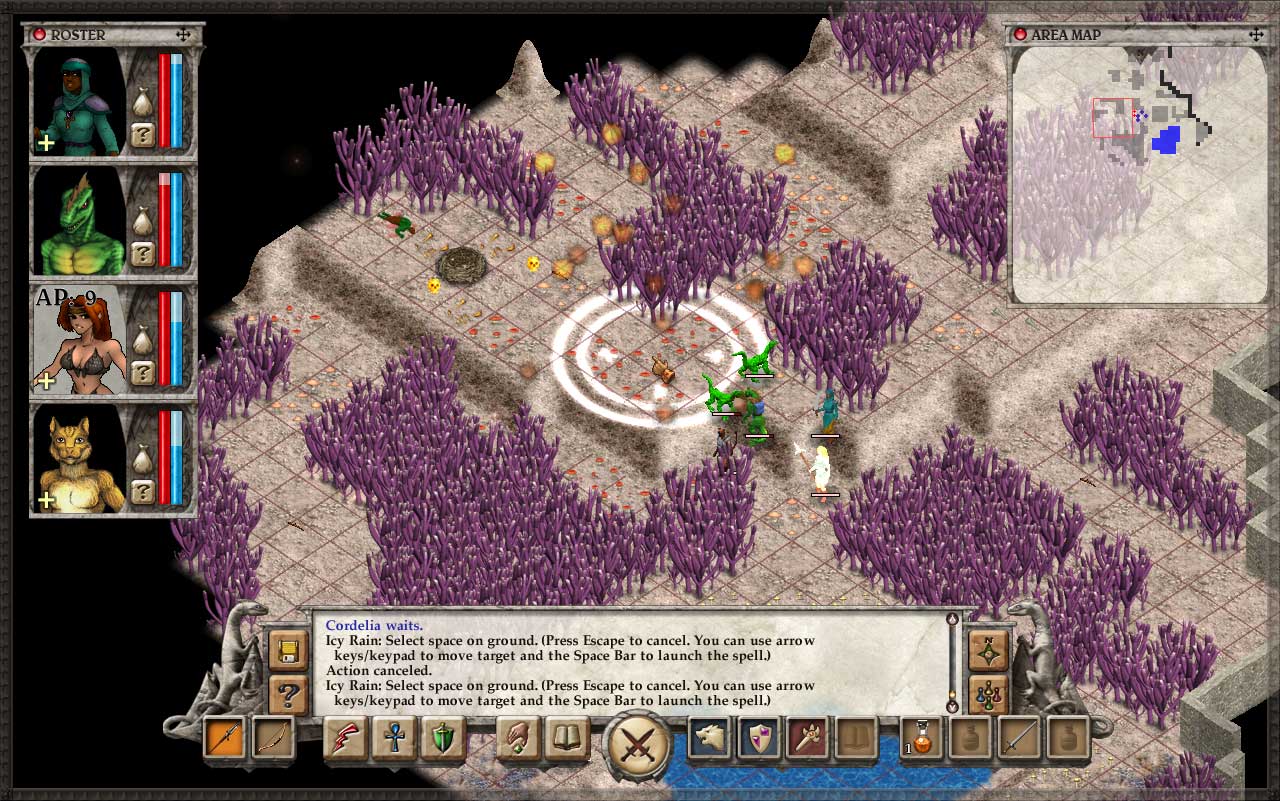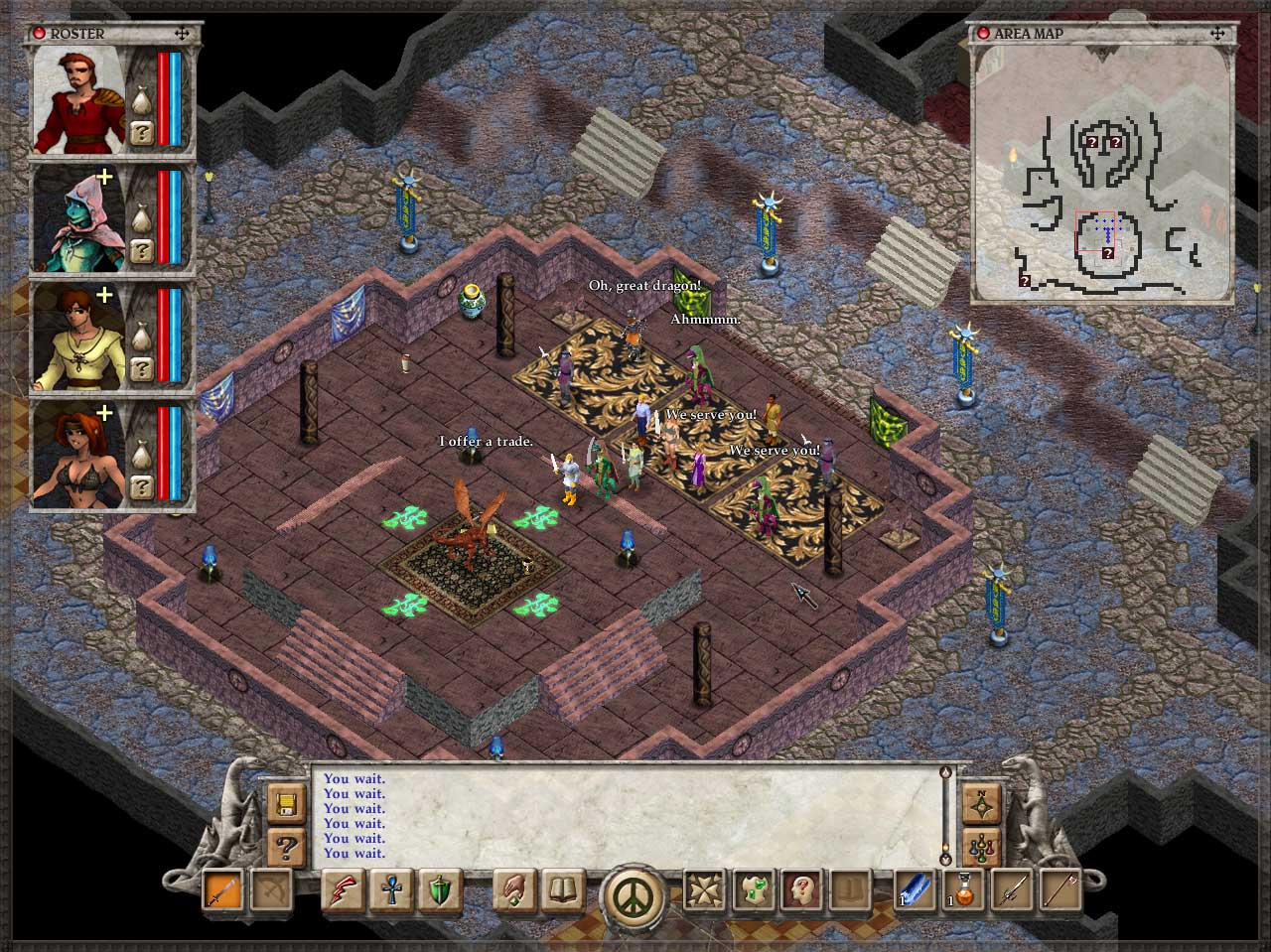Search
[{{{type}}}] {{{reason}}}
{{/data.error.root_cause}}{{{_source.title}}} {{#_source.showPrice}} {{{_source.displayPrice}}} {{/_source.showPrice}}
{{#_source.showLink}} {{/_source.showLink}} {{#_source.showDate}}{{{_source.displayDate}}}
{{/_source.showDate}}{{{_source.description}}}
{{#_source.additionalInfo}}{{#_source.additionalFields}} {{#title}} {{{label}}}: {{{title}}} {{/title}} {{/_source.additionalFields}}
{{/_source.additionalInfo}}- Details
- Category: Computer
- By J. Todd Cumming
- Hits: 8707
Avernum: The Complete Saga (Mac)

Avernum: The Complete Saga
Developed By: Spiderweb Software
Available On: Mac OS X, Windows
Genre: Turn-based role-playing game
Number of Players: 1 offline
Price: $11.99 from GOG.com, games can be purchased separately from the company or Steam for various prices.
In 1994, a small game company known as Spiderweb Software released a turn-based role-playing game called “Exile.” Nearly 20 years later, the company is still going strong, yet still only has three full-time staff members. The initial, award-winning “Exile” trilogy had been remade into the award-winning “Avernum” trilogy, and prompted the creation of a secondary trilogy. Now, all six games – along with a seventh game that serves primarily as a game editor and designer – can be purchased for one low price from the classic games website GOG.com.
The series starts with the creation of the underground lands of Avernum. Initially intended to be the home of those that don't fit in with the Empire's ideals, the refugees and exiles formed their own powerful kingdom. Over the course of the games, the player is encouraged to form a party of four characters in order to explore the subterranean lands – and in one case, venture onto the surface – and help Avernum solve its various problems.
The games largely follow the same basic gameplay. The player creates their characters by choosing a character race and a class. In all but the first game, the player can choose to create humans, a race of feline humanoids called the nephilim, or a race of lizardmen called the slithzerikai, each with their own strengths and disadvantages. The player also can choose a class for each character, or design their own custom class and allocate the skill points however they see fit. As is typical for most role-playing games, characters gain experience by solving quests and defeating creatures, and after gaining enough experience a character gains a level, which provides more skill points the player can use to increase their statistics.
The gameplay is about as close to a tabletop roleplaying experience you can have without being online with friends. The characters move around an isometric field, but combat and actions are turn-based, rather than real-time. Basic skills and most spells are pretty much the same throughout all six games. Hidden skills, which can be unlocked by allocating enough points in the basic skills, are introduced in the second trilogy, and special melee attacks are presented as options for combat-oriented builds in the fifth and sixth games. Even the same basic map is used for four of the six games, so once you get through one of the games, you have a good idea where things are located in many of the other games, too. Formello, the Great Castle, Erika's Tower... these are just a few of the locations that the player can visit and will become familiar with before too long.

Strong Points: Fascinating storyline; simple controls; hours of gameplay and replay value for a good price.
Weak Points: Graphics are dated; sound mediocre.
Moral Warnings: Fantasy violence; rebellion against authority; demons and undead appear frequently; magic use is a heavy part of the game; some scantily-clad pictures.
In contrast to making the games seem repetitive, they help to make each game feel more familiar as the player can focus on the real substance – the story. It's the plot elements that really make Avernum come to life. Each game is well-written and distinct. The controls and statistics almost become background maintenance so that the player can immerse themselves into the world that Spiderweb Software has created. Controls tend to be sharp and responsive, allowing the player to use the mouse or keyboard commands to move their characters and interact with items in the game world. There are occasional pathing issues, but most of the time these can be expected and accounted for. And with multiple save slots available, there are plenty of opportunities to save before making a move that turns out to be a major blunder.
The immersion elements do lead to one bit of criticism, though. The first trilogy really stood out as a sandbox-type environment. Basically, after being introduced to the world of Avernum in the first game, the players were then left to their own devices. Sure, some plot hooks were introduced to guide the player along, but they tended to be optional, as the player could then explore the game world at will – especially once they obtained enough money to purchase a boat. Sure, some of the areas were a bit dangerous – exploring the Giant Lands is extremely hazardous for a party of first level characters – but there was nothing stopping the player from going there anyway. This sandbox-type environment was finely executed in the third Avernum game, where the characters are hired to explore the surface. The player was free to go wherever he or she wanted to... but the creatures that were attacking the various cities on the surface weren't going to sit around and wait. As time went by, if the player did nothing to stop them, eventually enemies would overrun and destroy friendly settlements and NPCs. The third Avernum game really shone in terms of a game that had both sandbox and time management elements.
Unfortunately, this sandbox environment was erased with the second trilogy. The characters were introduced to each area, and were forbidden to go to the next area until certain quests had been completed. Although the storylines were still engaging, the railroad approach seems more confining and restrictive, especially after coming from the freedom of the first trilogy.

Higher is better
(10/10 is perfect)
Game Score - 82%
Gameplay - 17/20
Graphics - 8/10
Sound - 6/10
Stability - 5/5
Controls - 5/5
Morality Score - 64%
Violence - 4/10
Language - 7.5/10
Sexual Content - 6.5/10
Occult/Supernatural - 7/10
Cultural/Moral/Ethical - 7.5/10
Regardless of the approach, the Avernum series encourages replay value with the games through the implementation of multiple endings. Each game provides several hours of gameplay as it is, and players are encouraged to replay them through different difficulty levels and different endings. If the initial six games aren't enough, Blades of Avernum allows the user to create their own adventures, or download more scenarios that other users have created. Blades of Avernum uses the same engine as the first trilogy. Therefore, it does lack some of the elements that were introduced in the second trilogy, such as battle skills. However, users don't have to create a new party of characters for each scenario they want to play.
The graphics are clear enough, but show their age. Sometimes the same sprites are used throughout the entire series, including the character portraits. In fact, those familiar with Spiderweb Software's Geneforge series will notice some of the same sprites used in those games as well. The stock sound effects become a bit predictable as well, and while they aren't annoying, they do become a bit tired after several hours of repetitive use. Background music and voice acting – aside from the occasional dying scream – are nonexistent.
Although there is an overall storyline running through all six games, they don't need to be played in order, and experience with the previous games isn't needed to enjoy the newer ones. However, even though the story can continue, the player's characters can't. Each game begins with a new, level one party and a new tutorial starting area. While it is possible to recreate your previous characters using the character editor – accessible through a menu item that actually introduces the player to the cheat menu – doing so would pose little challenge as you take your party of level 35 characters though a level 3 dungeon.
From a moral standpoint, there are a few elements that could be questionable. As is typical for role-playing games, combat is heavily emphasized, and creatures – most of which tend to be humanoid – are dispatched with a little dying animation and a scream. The bodies vanish as they hit the ground, leaving behind the treasure they were carrying. While exploring, the player will discover an abundance of dead bodies in various states of decay – from fresh corpses to skeletal remains – that can be looted, as well as the occasional pool of blood. The small size of the sprites prevent the images from being too graphic, at least. It's also extremely easy to come across bones, piles of skulls, and even severed limbs (although each limb is depicted as a scaly arm, leaving it ambiguous as to whether it's a human leg or a lizard's foot) that can be picked up and carried, if a player wished to do so.

There are priests in the game and a form of religion that is rather ambiguous, with shrines dedicated to benevolent concepts such as luck or life, rather than actual deities. Undead creatures are commonplace as well, especially around Mertis, a city located in most of the games. Demons also tend to be a rather common enemy as the player reaches the upper levels, and can occasionally be summoned by desecrating evil altars. The player can also cast spells that can summon undead and occasionally demons to aid the party (the summons are determined randomly, so the player generally doesn't get a choice as to what creature comes to his aid).
A couple of the character portraits feature scantily-clad figures – namely a male barbarian in a loincloth, and a buxom woman in a chainmail bikini – but these images can never pop up again outside of character creation, so they can be easily avoided. Some of the games – especially the first one – encourages rebellion against the ruling powers that forced the denizens of Avernum underground in the first place, including the opportunity to assassinate the Emperor. The language tends to fairly clean, with the exception of hellhounds, which can be found in many of the games, and an occasional d***.
For those leery of the use of magic, some of the games features an interesting “cult” called the Anama, which is a religious order that believes the problems of the world have been caused by too much magic. In at least two of the games, the player can join this organization, which does prevent them from casting mage spells. However, priestly magic is still permitted, as is the usage of magic wands, scrolls, potions and crystals. Those familiar with fantasy role-playing games may not be bothered by these elements, however, since they're pretty typical for the genre.
The original Avernum series provides an excellent, if somewhat dated, role-playing experience, with hundreds of hours of gameplay for a very worthwhile price. If you're the kind of person who prefers to try a game before you buy it, you're in for an additional treat, as each of the Avernum games has a free demo available directly from Spiderweb's site. You may also note that the original game has been updated and remade for current operating systems and graphics cards, and is not part of the bundle I've mentioned earlier. In addition to GOG.com and Spiderweb's site, Avernum V and VI can be purchased from Steam, and Avernum VI is available for the iPad as well. It's certainly worth a try, at least, and if you enjoy it, you can obtain hours of fun for an incredibly low price.
--Sstavix








